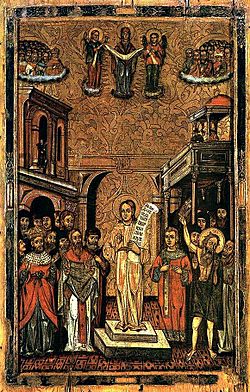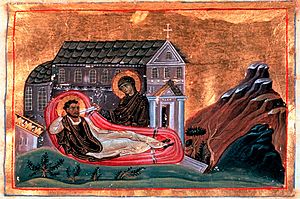Romanos the Melodist facts for kids
Quick facts for kids Saint Romanos |
|
|---|---|

Icon of Romanus the Melodist (1649)
|
|
| The Melodist | |
| Born | c. 490 Syria |
| Died | c. 556 Constantinople |
| Venerated in | Eastern Orthodox Church Roman Catholic Church |
| Feast | October 1 (October 14 N.S.) |
| Attributes | Young man vested as a deacon, standing on a raised platform in the middle of a church, holding a scroll with his Kontakion of the Nativity written on it. He is surrounded by the Patriarch, the Emperor, and members of the congregation. His icon is often a combined with that of The Protection of the Mother of God, which falls on the same day. Sometimes he is depicted as a deacon holding a censer in his right hand and a small model of a church in his left. |
| Patronage | church singers |
Saint Romanos the Melodist was a famous writer of church songs, also known as a hymnographer. People called him "the Pindar of rhythmic poetry" because his songs were so beautiful. He lived in the 500s, which was a "Golden Age" for writing church hymns in the Byzantine Empire.
Contents
Life of Saint Romanos
Most of what we know about Romanos comes from an old church book called the Menaion. A few other old writings also mention his name.
Romanos was born into a Jewish family in Syria, either in Emesa (now Homs) or Damascus. He was baptized as a young boy, meaning he became a Christian. We don't know if his parents also became Christians.
Later, he moved to Berytus (now Beirut). There, he became a deacon, which is a church leader who helps the priests. He served in the Church of the Resurrection in Beirut.
He then moved to Constantinople, a very important city at that time. This was during the rule of Emperor Anastasius. Most experts think it was Anastasius I, who ruled from 491 to 518. In Constantinople, Romanos worked as a sacristan in the "Great Church," which was the famous Hagia Sophia. He lived at the Monastery of Kyros until he died and was buried there with his student, Saint Ananias.
If he lived during the time of Anastasius I, he might have also written songs during the rule of Emperor Justinian (527-565). Justinian was also a hymn-writer. This would mean Romanos lived at the same time as two other famous Byzantine hymn writers, Anastasios and Kyriakos.
The Legend of Romanos
According to an old story, Romanos was not a very good reader or singer at first. But the Patriarch of Constantinople (the main church leader) liked him because he was very humble.
One time, around the year 518, Romanos was serving in the Church of the Panagia during a special night service for Christmas. He was supposed to read some verses from the Psalter (a book of psalms). But he read so badly that someone else had to finish for him. Some of the other church workers made fun of him.
Feeling sad and embarrassed, Romanos sat down in the choir stalls and fell asleep. While he was sleeping, the Theotokos (the Mother of God, Mary) appeared to him. She held a scroll in her hand and told him to eat it. As soon as he ate the scroll, he woke up.
He immediately got a blessing from the Patriarch. Then, he went up to the ambo (a raised platform for speaking in church) and started singing a new song without any practice. This song was his famous Kontakion of the Nativity, which begins, "Today the Virgin gives birth to Him Who is above all being…." Everyone there—the emperor, the patriarch, the clergy, and the whole church—was amazed. They were surprised by how deep the song's meaning was and how clear and beautiful Romanos's voice was.
People say this was the very first kontakion ever sung. The Greek word "kontakion" means the stick that a scroll is rolled around. This is why the Mother of God told him to swallow a scroll. It showed that his songs came from God. This scene of Romanos singing for the first time is often shown in paintings, especially in Pokrov icons.
Romanos's Works
Romanos wrote in a special Greek style that was popular but also very grand. His Jewish background might explain why his writing sometimes sounds like Semitic languages. His songs are known for their strong images, clear comparisons, bold ideas, and lively stories.
It is believed that Romanos wrote more than 1,000 hymns or kontakia. These songs celebrated different church holidays, the lives of saints, and other holy topics. About 60 to 80 of his songs still exist today, though some might not be truly his.
Today, usually only the first part of each kontakion is sung during church services. The full song has mostly been replaced by another type of hymn called a canon. A full kontakion was like a poetic sermon. It had 18 to 30 verses, each with a repeated line (a refrain). The first letters of the verses often spelled out a secret message, called an acrostic. When a kontakion was sung to a new tune, it was called an idiomelon. At first, Romanos's songs were just called "psalms," "odes," or "poems." The name "kontakion" only became common in the 800s.
Some of his well-known kontakia are about:
- The Nativity of Christ (Christmas)
- The death of St Stephen
- The Last Judgment
- The Prodigal Son
- The Raising of Lazarus (before Palm Sunday)
- Adam's Lament (for Palm Sunday)
- The betrayal by Judas
His Kontakion of the Nativity is still thought to be his best work. Until the 1100s, it was sung every year at the emperor's Christmas feast. The song is mostly a conversation between the Mother of God and the Magi (the wise men). In the Eastern Orthodox Church, the Magi's visit is celebrated on December 25, not January 6 like in Western churches. January 6 in the Orthodox Church celebrates the Baptism of Christ.
Another famous kontakion by Romanos is "My soul, my soul, why sleepest thou..." This song is sung during a special service called the "Great Canon" of St. Andrew of Crete during Great Lent.
Some people have said that Romanos wrote the famous Akathist Hymn to the Theotokos, which is still sung during Great Lent. However, most modern experts believe he did not write it, though some still disagree.
Professor Karl Krumbacher, a famous scholar, found and published some of Romanos's songs that had not been seen before. He found them in old books in a monastery library in Patmos. There is also a Greek manuscript in a library in Moscow that has kontakia for the whole year, but it doesn't have all of Romanos's songs.
Professor Krumbacher said about Romanos's work:
In poetic talent, fire of inspiration, depth of feeling, and elevation of language, he far surpasses all the other melodes. The literary history of the future will perhaps acclaim Romanos for the greatest ecclesiastical poet of all ages.
How Romanos is Shown in Art
In newer religious paintings (icons), Saint Romanos is shown standing on the ambo (a raised platform in front of the iconostasis, which is a screen with icons). He is wearing a deacon's sticharion (a long robe). However, an expert on church music, Johann von Gardner, says that in the oldest icons, Romanos is shown wearing a shorter red tunic like a singer. He stands on a raised platform in the middle of the church.
In the Eastern Church, Saint Romanos is the patron saint of church singers.
See also
 In Spanish: Romano el Méloda para niños
In Spanish: Romano el Méloda para niños


